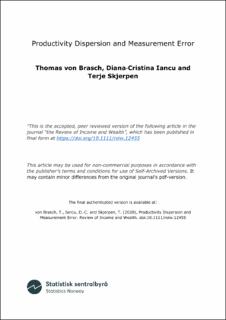| dc.contributor.author | von Brasch, Thomas | |
| dc.contributor.author | Iancu, Diana-Cristina | |
| dc.contributor.author | Skjerpen, Terje | |
| dc.date.accessioned | 2020-05-12T17:14:40Z | |
| dc.date.available | 2020-05-12T17:14:40Z | |
| dc.date.created | 2019-11-21T13:06:50Z | |
| dc.date.issued | 2019-11-11 | |
| dc.identifier.citation | von Brasch, T., Iancu, D.‐C. and Skjerpen, T. (2020), Productivity Dispersion and Measurement Error. Review of Income and Wealth. doi:10.1111/roiw.12455 | en_US |
| dc.identifier.issn | 0034-6586 | |
| dc.identifier.uri | https://hdl.handle.net/11250/2654145 | |
| dc.description.abstract | Several reasons have been put forward to explain the high dispersion of productivity across establishments: quality of management, different input usage and market distortions, to name but a few. Although it is acknowledged that a sizable portion of productivity dispersion may also be due to measurement error, little research has been devoted to identifying how much they contribute. We outline a novel procedure for identifying the role of measurement error in explaining the empirical dispersion of productivity across establishments. The starting point of our framework is the errors‐in‐variable model consisting of a measurement equation and a structural equation for latent productivity. We estimate the variance of the measurement error and subsequently estimate the variance of the latent productivity variable, which is not contaminated by measurement error. Using Norwegian data on the manufacture of food products, we find that about one percent of the measured dispersion stems from measurement error. | en_US |
| dc.language.iso | eng | en_US |
| dc.publisher | Wiley | en_US |
| dc.rights | Navngivelse-Ikkekommersiell-DelPåSammeVilkår 4.0 Internasjonal | * |
| dc.rights.uri | http://creativecommons.org/licenses/by-nc-sa/4.0/deed.no | * |
| dc.subject | Productivity dispersion | en_US |
| dc.subject | Measurement errors | en_US |
| dc.subject | Labor productivity | en_US |
| dc.subject | Establishment performance | en_US |
| dc.title | Productivity Dispersion and Measurement Error | en_US |
| dc.type | Peer reviewed | en_US |
| dc.type | Journal article | en_US |
| dc.description.version | acceptedVersion | en_US |
| dc.rights.holder | Copyright © John Wiley & Sons, Inc. All rights reserved | en_US |
| dc.subject.nsi | VDP::Matematikk og Naturvitenskap: 400::Matematikk: 410::Statistikk: 412 | en_US |
| dc.subject.nsi | VDP::Samfunnsvitenskap: 200::Økonomi: 210 | en_US |
| dc.source.pagenumber | 12 | en_US |
| dc.source.journal | The Review of Income and Wealth | en_US |
| dc.identifier.doi | 10.1111/roiw.12455 | |
| dc.identifier.cristin | 1750476 | |
| cristin.ispublished | true | |
| cristin.fulltext | postprint | |
| cristin.qualitycode | 1 | |

